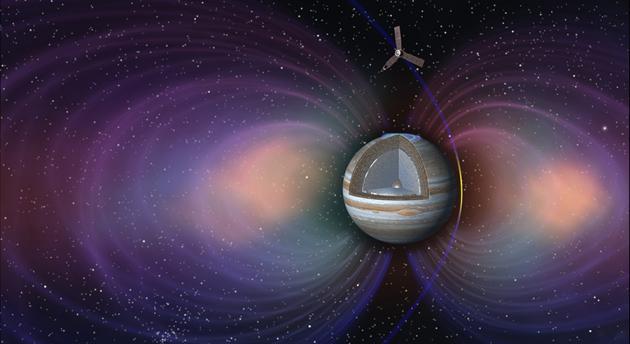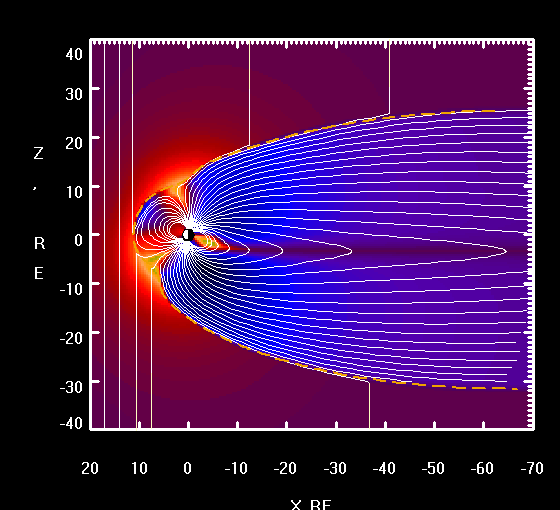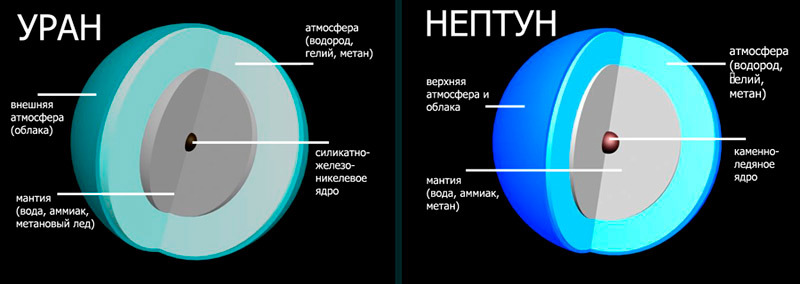Magnetic shields of planets. On the diversity of sources of magnetospheres in the solar system

6 of the 8 planets of the solar system have their own sources of magnetic fields that can deflect the flow of charged particles of the solar wind. The volume of space around the planet, within which the solar wind deviates from the trajectory, is called the planet’s magnetosphere. Despite the common physical principles of magnetic field generation, sources of magnetism, in turn, vary greatly among different groups of planets in our stellar system.
The study of the diversity of magnetic fields is interesting in that the presence of the magnetosphere is supposedly an important condition for the emergence of life on the planet or its natural satellite.
Iron and stone
For terrestrial planets, strong magnetic fields are the exception rather than the rule. The most powerful magnetosphere in this group is our planet. The solid core of the Earth is supposedly composed of a nickel-iron alloy heated by radioactive decay of heavy elements. This energy is transferred by convection in the liquid outer core to the silicate mantle ( more ). Until recently, thermal convective processes in a metal external core were considered to be the main source of geomagnetic dynamo. However, studies in recent years refute this hypothesis .

The interaction of the planet’s magnetosphere (in this case, the Earth) with the solar wind. The streams of the solar wind distort the magnetospheres of the planets, which have the form of a highly elongated magnetic "tail" directed in the opposite direction from the Sun. The magnetic "tail" of Jupiter stretches for more than 600 million km.
')
Supposedly, a source of magnetism during the existence of our planet could be a complex combination of various mechanisms for generating a magnetic field: the initial initialization of a field from an ancient collision with a planetoid; non-thermal convection of different phases of iron and nickel in the outer core; separation of magnesium oxide from the cooling of the external core; tidal influence of the moon and the sun, etc.
The bowels of the “sister” of Earth - Venus practically do not generate a magnetic field. Scientists are still arguing about the reasons for the lack of a dynamo effect. Some blame the slow daily rotation of the planet, while others object that this should have been enough to generate a magnetic field. Most likely, the matter is in the internal structure of the planet, which is different from the earth ( more ).

It is worth making a reservation that Venus has a so-called induced magnetosphere created by the interaction of the solar wind and the ionosphere of the planet.
The closest (if not identical) to Earth on the duration of sidereal days of Mars. The planet rotates around its axis in 24 hours, just as the two “colleagues” of the giant described above consist of silicates and a quarter of the iron-nickel core. However, Mars is an order of magnitude lighter than Earth, and, according to scientists, its core has cooled relatively quickly, so the planet does not have a dynamo generator.

The internal structure of the iron-silicate planets of the terrestrial group
Paradoxically, the second planet in the earth group, which can "boast" of its own magnetosphere is Mercury, the smallest and easiest of all four planets. Its proximity to the Sun predetermined the specific conditions under which the planet was formed. So, unlike the rest of the planets of the group, Mercury has an extremely high relative proportion of iron to the mass of the entire planet - on average 70%. Its orbit has the strongest eccentricity (the ratio of the nearest orbit point from the Sun to the most distant point) among all the planets of the solar system. This fact, as well as the proximity of Mercury to the Sun increase the tidal effect on the iron core of the planet.

Mercury Magnetosphere Diagram with Superimposed Magnetic Induction Graph
Scientific data obtained by spacecraft suggest that the magnetic field is generated by the movement of the metal in the core of Mercury melted by the tidal forces of the Sun. The magnetic moment of this field is 100 times weaker than Earth's, and the dimensions are comparable with the size of the Earth, not least because of the strong influence of the solar wind.

The magnetic fields of the Earth and the planets of the giants. The red line is the axis of the daily rotation of the planets (2 is the inclination of the poles of the magnetic field to this axis). The blue line is the equator of the planets (1 is the inclination of the equator to the ecliptic plane). The magnetic fields are represented in yellow (3 - magnetic induction, 4 - the radius of the magnetospheres in the radii of the corresponding planets)
Metal giants
The planets, the giants Jupiter and Saturn, have large cores of rocks, weighing 3–10 terrestrial, surrounded by powerful gas shells, on which the overwhelming majority of the planets accounted for. However, these planets have extremely large and powerful magnetospheres, and their existence cannot be explained only by the dynamo effect in stone nuclei. Yes, and it is doubtful that with such a colossal pressure there are generally possible phenomena similar to those occurring in the core of the Earth.
The clue is in the hydrogen-helium envelope of the planets. Mathematical models show that in the depths of these planets, hydrogen from a gaseous state gradually passes into a state of superfluid and superconducting liquid — metallic hydrogen. Metallic it is called due to the fact that at such values of pressure hydrogen exhibits the property of metals.

The internal structure of Jupiter and Saturn
Jupiter and Saturn, as is characteristic of the planets to the giants, retained in the depths of the large thermal energy accumulated during the period of the formation of the planets. The convection of metallic hydrogen transports this energy into the gas envelope of the planets, determining the climatic situation in the atmospheres of giants (Jupiter radiates into the space twice as much energy as it receives from the Sun). Convection in metallic hydrogen in combination with the fast daily rotation of Jupiter and Saturn presumably form powerful planetary magnetospheres.

At the magnetic poles of Jupiter, as well as at the similar poles of the other giants and the Earth, the solar wind causes "polar" auroras. In the case of Jupiter, such large satellites as Ganymede and Io produce a significant effect on its magnetic field (a trace is visible of the flux of charged particles “flowing” from the corresponding satellites to the magnetic poles of the planet). The study of the magnetic field of Jupiter is the main task of the automatic station "Juno" operating in its orbit. Understanding the origin and structure of the giant planets' magnetospheres can enrich our knowledge of the Earth’s magnetic field.
Ice Generators
The ice giants Uranus and Neptune are so similar to each other in size and mass that they can be called the second pair of twins in our system, after Earth and Venus. Their powerful magnetic fields occupy an intermediate position between the magnetic fields of the gas giants and the Earth. However, here the nature "decided" to originate. The pressure in the iron-core nuclei of these planets is still too great for a dynamo effect like that of the earth, but not enough to form a layer of metallic hydrogen. The core of the planet is surrounded by a thick layer of ice from a mixture of ammonia, methane and water. This "ice" is actually an extremely heated liquid that does not boil solely due to the enormous pressure of the atmospheres of the planets.

The internal structure of Uranus and Neptune

The axis of the magnetic field of Uranus, as in Neptune, is strongly biased relative to the center of the planet. On the right is the atmosphere of the atmosphere at the magnetic poles of Uranus (white spot) taken by the Hubble telescope
As in the case of the gas giants, the heat from the bowels of the planets is transferred by convective processes to the atmosphere of Neptune and Uranus. Mathematical models show that the liquid from methane, ammonia and water has a high electrical conductivity. At a certain depth of this ice mantle, in a thin layer, the pressure becomes favorable for the fact that the hydrodynamic effect of convection begins to generate the magnetic fields of the planets.
Source: https://habr.com/ru/post/398061/
All Articles